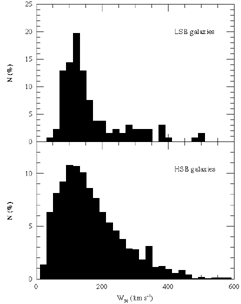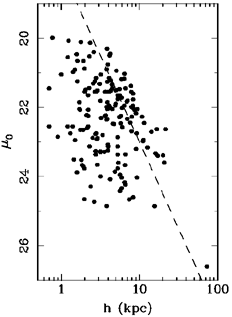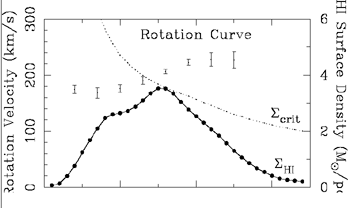


6.4.2. The Properties of LSB Galaxies
The known properties of LSB galaxies can be summarized as follows:
1. LSB disk galaxies are not exclusively of low mass. This is
clearly seen in the distribution of 21-cm velocity widths which is
indistinguishable from any sample of Hubble Sequence spirals. This
is shown in Figure 6-13. LSB disks
have similar sizes and masses as those high surface brightness (HSB)
that define the Hubble sequence. However, despite this evidence to
the contrary, the notion that LSB galaxies are exclusively low mass
(or "dwarf") galaxies still permeates the community. Indeed,
a small percentage of the LSB population has
truly impressive overall sizes with scale lengths that exceed 15 kpc.
Figure 6-14 shows that when one closes in on
a representative sample of
galaxies, the entire disk structural plane defined by
 l and
µ0 is populated.
l and
µ0 is populated.

|
Figure 6-13: Comparison of 21-cm linewidths for the sample of normal spirals shown in Figure 6-4 to the LSB samples. The same range of rotational velocities is sampled with the same frequency of occurrence. confirms the object as being well behind the Virgo cluster. |
2. Very few LSB galaxies show evidence for nuclear activity. This is in
marked contrast to HSB disk galaxies where the percentage which have
Active Galactic Nuclei can be as high as 50% depending on the mean
luminosity of the sample. The most probable explanation for this
is that LSB disks, in general, are lacking two structural features
that facilitate gas flows and/or the formation of a compact object in
the nucleus. These structural features are 1) bulges and 2) bars.
In this context it is interesting to note that of those large
 LSBs (e.g., Malin 1 and
cousins), approximately 50% do show
some nuclear activity and all have a normal bulge component with
luminosity MB: -18 to 20. These galaxies are truly
enigmatic in
that it appears "normal" formation processes were at work to create
the bulge component but no conspicuous stellar disk ever formed around
this bulge.
LSBs (e.g., Malin 1 and
cousins), approximately 50% do show
some nuclear activity and all have a normal bulge component with
luminosity MB: -18 to 20. These galaxies are truly
enigmatic in
that it appears "normal" formation processes were at work to create
the bulge component but no conspicuous stellar disk ever formed around
this bulge.

|
Figure 6-14: Parameter space defined by central surface brightness and scale length after LSBs are included in the overall sample. The dashed line is a line of constant disk luminosity. |
3. The amount of neutral hydrogen in LSB disks is very similar to HSB spirals except for their lower than average surface densities. A typical case is shown in Figure 6-15 where it can be seen that the gas density is generally below the threshold for molecular cloud formation and hence widespread disk star formation and metal production. Indeed, LSB spirals are significantly deficient in molecular gas compared to HSB spirals of the same mass. The observations of Schombert et al. (1990) failed to detect a single LSB disks in CO and virtually none of the LSB galaxies detected by Schombert et al. 1992, or Impey et al. 1996, are IRAS sources.

|
Figure 6-15: The 21-cm profile of the large LSB disk UGC 6614 in comparison with the critical density profile and the rotation curve. The surface density of H I is below the critical density and all points and hence star formation is not expected to occur in this disk. |
Although a typical LSB disk contains a handful of bright H II regions, indicating some current star formation, the average star formation rate is at least an order of magnitude lower than in similar mass galaxies. In our galaxy star formation is observed to only occur in GMCs (e.g., Young and Scoville 1991). LSB galaxies may well be devoid of molecular clouds in their Interstellar Medium but nevertheless formed some stars. In fact, it is likely that the pressure-temperature-density manifold in LSB disks hysically precludes molecular cloud formation but this has not been. The expectation of low metallicity is confirmed by the observations of McGaugh (1992). As derived from H II region spectroscopy, the the abundance of heavy elements such s oxygen, nitrogen, neon and sulfur can be an order of magnitude lower than HSB disks of the same mass. On average, LSB disk galaxies with L* luminosities have abundances of ~ 1/3 solar (McGaugh 1994) Thus, LSB galaxies strongly violate the mass-metallicity relation as defined by Hubble sequence spirals. This straightforwardly shows that multiple paths of chemical evolution exist for disk galaxies which demands multiple star formation histories. In the case of LSB disks, that star formation history has not been robust and hence they represent some of the most unevolved objects in the universe.
4. Until very recently, little to nothing was know about the dynamics of rotating LSB disks. Optically, LSB disks galaxies rarely show the symmetry that is usually exhibited by Hubble Sequence spirals (but see Zaritsky 1997). To first order, strongly symmetric optical disks are a signature of rotation dominated kinematics within relatively cold disks. The "chaotic" optical appearance of many LSB disks then might suggest peculiar kinematics but this is not consistent with the global 21-cm profiles which, in general, show the two-horned signature of a rotating disk. The gas-rich nature of some LSB disks makes it possible to determine their rotation curves from aperture -synthesis data. Two groups (de Blok et al. 1996; Pickering et al. 1997) have used the VLA and WSRT radio arrays to determine the 2D distribution of H I in about a dozen LSB galaxies. The results of these efforts can be summarized as follows:
 LSB galaxies have rotation
curves that have a significantly
shallower rise compared to HSB galaxies of the same rotation velocity /
mass.
LSB galaxies have rotation
curves that have a significantly
shallower rise compared to HSB galaxies of the same rotation velocity /
mass.
 The gaseous component of
LSBs is dynamically significant at virtually all radii.
The gaseous component of
LSBs is dynamically significant at virtually all radii.
 LSB disks are highly dark
matter dominated at virtually all
radii. Compared again to HSB galaxies of the same rotational velocity,
LSB disks have globally and locally higher values of M / L (see also
de Blok and McGaugh 1996).
LSB disks are highly dark
matter dominated at virtually all
radii. Compared again to HSB galaxies of the same rotational velocity,
LSB disks have globally and locally higher values of M / L (see also
de Blok and McGaugh 1996).
 In contrast to HSB galaxies,
no "maximum disk" mass model
fits the rotation curve. This means that there is no region in an
LSB disk where the luminous (baryonic) matter dominates the potential
and hence determines the form of the rotation curve.
In contrast to HSB galaxies,
no "maximum disk" mass model
fits the rotation curve. This means that there is no region in an
LSB disk where the luminous (baryonic) matter dominates the potential
and hence determines the form of the rotation curve.
 Mass models derived from the
rotation curves of LSB and
HSB galaxies show that LSB galaxies inhabit less dense and more extended
dark matter halos.
However, they have dynamical masses comparable to those of HSB galaxies.
Mass models derived from the
rotation curves of LSB and
HSB galaxies show that LSB galaxies inhabit less dense and more extended
dark matter halos.
However, they have dynamical masses comparable to those of HSB galaxies.
 The most extreme examples
give very hard upper limits to the
ratio of disk to halo mass. These result in baryon fractions of
The most extreme examples
give very hard upper limits to the
ratio of disk to halo mass. These result in baryon fractions of
 10%
at the most, and more likely
10%
at the most, and more likely  3%. The value of fb as measured in LSB
disks is significantly lower than that which is measured in clusters of
galaxies (e.g., White et al. 1993). So which is the more
representative baryonic repository, clusters of galaxies or LSB
disks? Arguments given in Impey and Bothun (1997) show that LSB galaxies
make a substantial contribution to the total baryonic mass density
in the Universe, providing up to half of it depending on the faint
end slope of the luminosity function (see below).
3%. The value of fb as measured in LSB
disks is significantly lower than that which is measured in clusters of
galaxies (e.g., White et al. 1993). So which is the more
representative baryonic repository, clusters of galaxies or LSB
disks? Arguments given in Impey and Bothun (1997) show that LSB galaxies
make a substantial contribution to the total baryonic mass density
in the Universe, providing up to half of it depending on the faint
end slope of the luminosity function (see below).
This dynamical information now allows LSB disks to be described in a manner that is fundamentally different than HSB disk galaxies with the profound implication that the density profile of the dark matter halo ultimately determines the surface density of the galaxy which forms in that potential. Thus LSB galaxies may well have a fundamentally different dark matter distribution in them compared to HSB galaxies. This makes LSB disks physically distinct from HSB disks, even though they may have similar global properties. The paradoxical observation that LSB disks lie on the same Tully-Fisher relation as HSB disks (albeit with significantly more scatter) can then be understood only if the ratio of dark-to-light matter in disk galaxies is independent of the dark matter halo density. In this case, galaxies of the similar circular velocity but dissimilar surface brightnesses can have the same luminosity because the LSB galaxy is defined by a larger radius which contains the mass that determines the circular velocity. This means that LSB disks also have lower surface mass density.